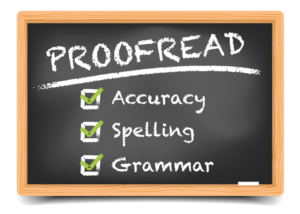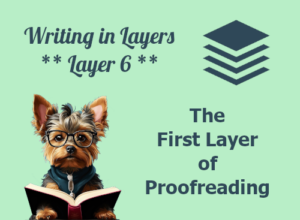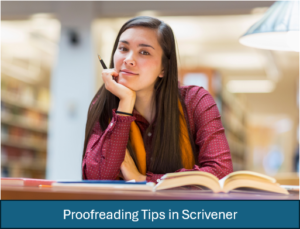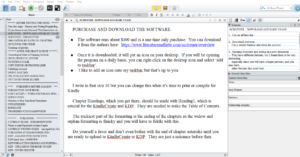PROOFREADING WHILE STILL IN SCRIVENER:
 There are two levels of proofreading. The first level is proofreading for plot context to make sure the novel is complete. Before I leave Scrivener, I go over the different chapters and scenes and mark the following beats and make sure that everything is included.
There are two levels of proofreading. The first level is proofreading for plot context to make sure the novel is complete. Before I leave Scrivener, I go over the different chapters and scenes and mark the following beats and make sure that everything is included.
Before I post the checklist, I need to say that I did not invent these ideas below. I have been listening to videos by other authors for several years now and I have taken copious notes and somewhere along the way I took a little from one author and a little from another. I think them all for their generosity in sharing their experience and knowhow.
- Proofread and make sure you indicate where the following items are
a. The Hook - This is the thing or the event that will hook the reader's interest.
b. The Setup - This includes the setting where the story will take place. It also includes an introduction to the main protagonist/hero and what his or her wants or needs are in life, so to speak. This is the starting point of the quest. (The Quest)
c. Identify the subplot. Be clear on how the subplot affects the plot.
d. Inciting incident - This is the point where the story has it's first twist or turn. The Hero is pulled into a quest that he starts out not really wanting to go on. This is going in a different direction than "the setting".
e. Setback(s): Depending upon what type of novel you are writing, you will have one or more setbacks that create conflict and drama that move the story forward. You may want to clearly mark these as well.
f. Major setback: about 75% of the way through the book, the big setback happens when things look like they are not going to work out.
g. The final battle/The Climax - In high suspense novels, this can be a physical battle for life and death. In a less dramatic story, this is where the hero has to conquer himself or herself in order to be able to pull off their quest.
h. All is lost - Right before the Hero gets their second wind and has a breakthrough, they will have a moment of despair where all will seem lost.
i. The glorious/surprise ending - Hero wins/gets what they want
j. The aftermath - 99% point of the story - This is where the story wraps up and you see the "new normal" now that the hero has broken through their fears and saved things. - Check the following about the subplot:
k. "Subplot Development" - any crisis, suspense, etc.
l. Any plot twists or pathway turns for the subplot
m. Point out where subplot reaches high tension
n. Point out where the subplot is setback or fails, or feels at a standstill
o. Scene that resolves the whole story - Make a document to check your background and descriptions
p. Make sure you don't repeat information in multiple places. Make a separate sheet and record which chapters your descriptions and background info is at. This way you can make sure you have included everything and also make sure you haven't repeated anything.
q. For the series books, make sure you include enough background
for it to be a stand-alone book.





